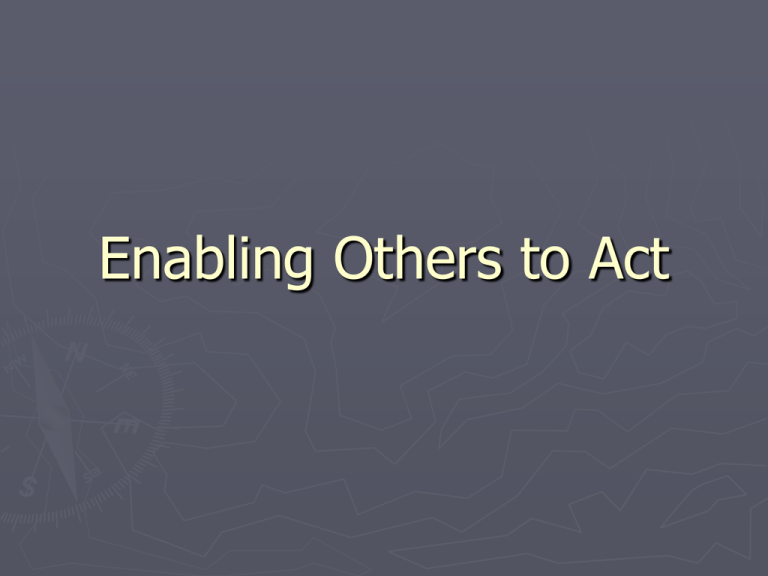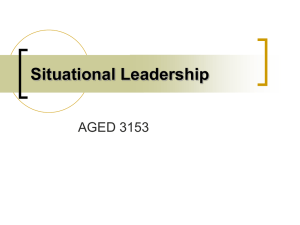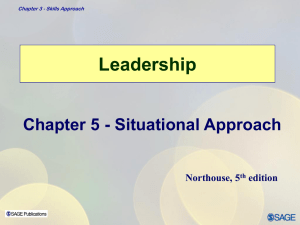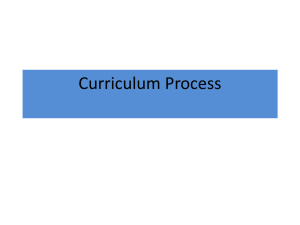Week 4 - Azusa Pacific University
advertisement

Enabling Others to Act Introductory thoughts ► Leader – Follower is a relationship ► This principle focuses on the follower ► “Foster collaboration by promoting cooperative goals and building trust” ► “Seeing the magnificence in all people – dedicated to their fullest success” Module V Themes ► ► ► ► ► ► ► ► ► ► ► Collaboration Trust Connecting Empowering Environment for success Coaching Information Accountability Delegating Power Influence Module V Devotion - Daniel Module V Summary of Leadership Theory ► Trait Theory ► Situational Theory ► Charismatic Theory ► Transformational Leadership Module V Trait Theory ► Personal characteristics of a leader ► Bass (1990) – prior to WW II Capacity (e.g. intelligence) Achievement (e.g. Scholarship) Responsibility (e.g. Self-confidence) Participation (e.g. socialbility) Status (e.g. economics) Situation (e.g. skills) Module V Trait Theory ► Post WW II (Stogdill, 1970) Skill (e.g. Intellectual) Relational behaviors (e.g. nurturing) Personal (e.g. able to communicate) Module V Power and influence Theories ► Power is the capacity to take action or force a desired outcome or behavior in others (Janda, 1960) ► Influence is the subordinate’s perception of a leader’s power to take action (Ziller, 1955) Module V Five types of Power (French & Raven) ► Personal power Personal Positional ► Positional power Reward Coercive Legitimate Module V Behavioral Theories ► Style approach of leaders ► Behavior and relationships ► McGregor’s Theory X and Theory Y Module V Situational Theories ► Leaders behave differently according to context ► Contingency Model (Fiedler, 1967) ► Situational Model (Hersey&Blanchard, 1969) Module V Situational Theory ► Golemans model (2002) Coaching leaders Pacesetting leaders Democratic leaders Affiliative leaders Authoritative leaders Coercive leaders Module V Situational Theory ► Hersey & Blanchard (1969) Module V Situational Approach Description “Leaders match their style to the competence and commitment of subordinates” Perspective ► ► ► Developed by Hersey & Blanchard (1969); based on Reddins (1967) 3-D Management Style Leader-focused perspective Used extensively in organizational leadership training and development Definition ► Comprised of: Directive dimension Supportive dimension ► Each Module V dimension must be applied appropriately in a given situation ► Leaders evaluate employees to assess their competence and commitment to perform a given task Leadership Styles Definition ► The behavior pattern of an individual who attempts to influence others; includes: Directive (task) behaviors Supportive (relationship) behaviors Dimension Definitions ► Directive behaviors - Help group members in goal achievement via one-way communication through: Giving directions Establishing goals & how to achieve them Methods of evaluation & time lines Defining roles ► Supportive behaviors - Assist group members via two-way communication in feeling comfortable with themselves, coworkers, and situation Module V High The Four Leadership Styles S3 S2 High Supportive Low Directive High Directive High Supportive S4 S1 Low Supportive Low Directive Low High Directive Low Supportive Directive Behavior High D4 Developed High Low D1 Moderate D3 D2 Module V Developing Developmental Level of Followers S1 - Directing Style ► Leader focuses communication on goal achievement S1 ► Spends LESS time using supportive behaviors High Directive Low Supportive Module V S2 - Coaching Style ► S2 High Directive High Supportive ► Leader focuses communication on BOTH goal achievement and supporting subordinates’ socioemotional needs Requires leader involvement through encouragement and soliciting subordinate input Module V S3 - Supporting Style ► S3 High Supportive Low Directive ► Leader does NOT focus solely on goals; rather the leader uses supportive behaviors to bring out employee skills in accomplishing the task Leader delegates day-today decision-making control, but is available to facilitate problem solving Module V S4 - Delegating Style ► S4 ► Low Supportive Low Directive ► Leader offers LESS task input and social support; facilitates subordinates’ confidence and motivation in relation to the task Leader lessens involvement in planning, control of details, and goal clarification Gives subordinates control and refrains from intervention and unneeded social support Module V Development Levels Definition ► Dimension Definitions The degree to which subordinates have the competence and commitment necessary to accomplish a given task or activity High D4 Developed D1 D2 D3 D4 Low Competence High Commitment Some Competence Low Commitment Mod-High Competence Low Commitment High Competence High Commitment Moderate D3 Low D1 D2 Module V Developing Developmental Level Of Followers How Does the Situational Approach Work? ► ► ► ► Focus of Situational Approach Strengths Criticisms Application Situational Approach Focus Centered on the idea subordinates vacillate along the developmental continuum of competence and commitment ► Leader effectiveness depends on assessing subordinate’s developmental position and adapting his/her leadership style to match subordinate developmental Module V level ► “The Situational approach requires leaders to demonstrate a strong degree of flexibility.” Strengths ► ► ► ► ► Marketplace approval. Situational leadership is perceived as providing a credible model for training employees to become effective leaders. Practicality. Situational leadership is a straightforward approach that is easily understood and applied in a variety of settings. Prescriptive value. Situational leadership clearly outlines what you should and should not do in various settings. Leader flexibility. Situational leadership stresses that effective leaders are those who can change their style based on task requirements and subordinate needs. Differential treatment. Situational leadership is based on the premise that leaders Module V need to treat each subordinate according to his/her unique needs. Criticisms ► Lack of an empirical foundation raises theoretical considerations regarding the validity of the approach ► Further research is required to determine how commitment and competence are conceptualized for each developmental level ► Conceptualization of commitment itself is very unclear ► Replication studies fail to support basic prescriptions of situational leadership model ► Does not account for how particular demographics influence the leader-subordinate prescriptions of the model ► Fails to adequately address the issue of one-to-one versus group leadership in an organizational setting Module V ► Questionnaires are biased in favor of situational leadership Application ► Often used in consulting because it’s easy to conceptualize and apply ► Straightforward nature makes it practical for managers to apply ► Breadth of situational approach facilitates its applicability in virtually all organizations Module V Leader-Member Exchange Theory(LMX) ► “Special Relationships” ► Not everyone is treated the same ► Relationships change over time Module V LMX Theory Followers Over time Defined into “in-group” Leader-member Exchange Relationships Followers Over time Defined into “out-group” Perceptions of Followers •Compatibility •Competence •Personality “-” “+” Module V Questions for discussion ► Do the leadership style and follower maturity/readiness match-ups in the situational model make sense based on your personal experiences? ► If you are in the “out-group” with a leader, what could you do to move into the “ingroup”? Module V Charismatic Leader Theory Charismatic leadership is leadership based on the leader's ability to communicate and behave in ways that reach followers on a basic, emotional way, to inspire and motivate. We often speak of some sports and political leaders as charismatic (or not) -- an example being John F. Kennedy. ► It's difficult to identify the characteristics that make a leader "charismatic", but they certainly include the ability to communicate on a very powerful emotional level, and probably include some personality traits. ► Developing "charisma" is difficult, if not impossible for many people, but luckily charismatic leadership is not essential to be an effective leader. Many other characteristics are involved in leading effectively, and there is significant evidence to indicate that it simply is not necessary to have this elusive Module Vcharisma to lead others well. ► Charismatic Leader Theory Relying on charisma to lead also can be problematic. For example, there have been many charismatic leaders who lack other leadership characteristics and skills (e.g. integrity) and lead their followers into situations that turn out horribly -- think political leaders such as Stalin, Hitler, and even business leaders (Enron). ► Finally, in organizations lead by charismatic leaders, there is a major problem regarding succession. What happens when a leader who relies on charisma leaves? Often the organization founders because the ability to lead rested with one person's charisma. ► Module V Transformational Leaders ► ► ► Transformational Leadership - More of a Partner Approach If transactional leadership involves the use of leadership power over rewards and punishments to "lead", transformational leadership can be characterized as a process where leader and followers work together, in a way that changes, or transforms the organization, the employees/followers and the leader. It recognizes that real leadership involves transformation and learning on the part of follow AND leader. As such it is more of a partnership, even though there are power imbalances involved. Module V Trust and Leaders ► http://www.olin.wustl.edu/faculty/dirks/trust %20in%20leader%20chapter.pdf ► Positive interdependence ► Mutual respect and fairness ► Facilitating others to sources of power ► Sharing of information and resources ► Create an environment for informal opportunities and interactions Module V “The Last Castle” ► What are the traits of prisoner Irwin? ► Relationships: Irwin and Yates Irwin and Aguilar Irwin and the sergeant major How is situational leadership shown in these relationships? ► Contrast the leadership styles of Winter and Irwin (formal/informal, transactional/transformational etc.) Module V Transformational Leaders ► While transactional leadership involves telling, commanding, or ordering (and using contingent rewards) transformational leadership is based on inspiring, getting followers to buy-in voluntarily, creating common vision. ► Transformational leadership is what most of us refer to when we talk about great leaders in our lives and in society Module V








